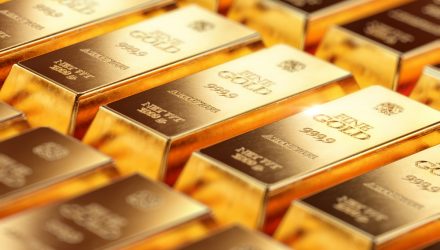While bearishness might be pushing gold lower, it could present a value option while commodities could be pulled higher with global inflation.
This push-pull commodity could be captured in two exchange traded funds (ETFs) from Invesco: One for capturing gold prices at their lowest should they continue faltering, and the other for commodities rising higher amid inflation.
At the center of this push-pull dichotomy is the Federal Reserve, which is expected to tighten monetary policy and raise interest rates. The latter, of course, doesn’t bode well for gold as the U.S. dollar continues to gain strength.
“An unwinding in ultra-accommodative central bank policy will be most outright bearish for gold and silver over the course of 2022,” JPMorgan analysts write. “From an average of $1,765/oz in Q1, gold prices are set to steadily decline over the course of next year to a Q4 average of $1,520/oz.”
As such, an ETF to watch is the Invesco DB Gold Fund (DGL), which seeks to track changes, whether positive or negative, in the level of the DBIQ Optimum Yield Gold Index Excess Return™ plus the interest income from the fund’s holdings of primarily U.S. Treasury securities and money market income less the fund’s expenses. The fund is designed for investors who want a cost-effective and convenient way to invest in commodity futures.
A Broad Commodities ETF
If gold heads lower, then investors can hedge with a broad commodities play. One such ETF to use to get this aggregate exposure is the Invesco DB Commodity Index Tracking Fund (DBC).
“Commodities are on pace to deliver the strongest year of returns since the early 2000s. A constructive economic outlook, depleted inventory levels and supply still struggling to respond to resurgent demand point to a second consecutive year of positive double-digit commodity returns in 2022,” said Natasha Kaneva, head of the global commodities strategy at JPMorgan.
Commodities typically march to the beat of their own drum, giving a portfolio much-needed diversification. When interest rates do eventually rise, commodity prices are expected to move higher as well.
Per the fund’s description, DBC seeks to track changes, whether positive or negative, in the level of the DBIQ Diversified Agriculture Index Excess Return™, plus the interest income from the fund’s holdings of primarily U.S. Treasury securities and money market income less the fund’s expenses.
For more news, information, and strategy, visit the Innovative ETFs Channel.








